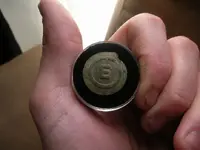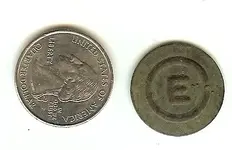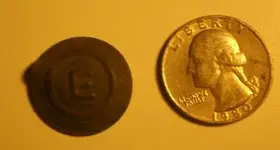I'd like to comment about the form (or as it's called nowadays, font) of the letter. A general rule of thimb regarding letters stamped into metal is that in the civil war era and earlier, most had "serifs" ...the little prongs on the arms of a letter. "Plain" letters become much more frequent after the civil war ended. For example, the lettering on almost every pre-1866 button backmark has serifs. Then in the Indian Wars era, you start seeing lots of "plain-letter" backmarks. So, a useful tip to remember is that if a button's backmark has "plain" lettering it's almost certainly Indian Wars era or later.
The rule-of-thumb about "plain" letters is generally true with the lettering on US coins.
I think the change is related to the cost of a skilled diemaker's labor. Fancy lettering is more costly to do than "plain" lettering.
So to me, at least, the "plain" letter E on these discs is an indication that it was made in the latter 1800s, if not later.







 That doesnt sound like a company logo fell off.
That doesnt sound like a company logo fell off.  .. 3rd and last I found in Hampton in a yard that gave up CW all the way thru 1900's stuff as well.
.. 3rd and last I found in Hampton in a yard that gave up CW all the way thru 1900's stuff as well. 
![Picture 029[1].webp](/data/attachments/248/248816-f0b36c582892e41646d803314d782de4.jpg?hash=99pFq_W6kt)
![Picture 029[1].webp](/data/attachments/248/248824-f0b36c582892e41646d803314d782de4.jpg?hash=99pFq_W6kt)



